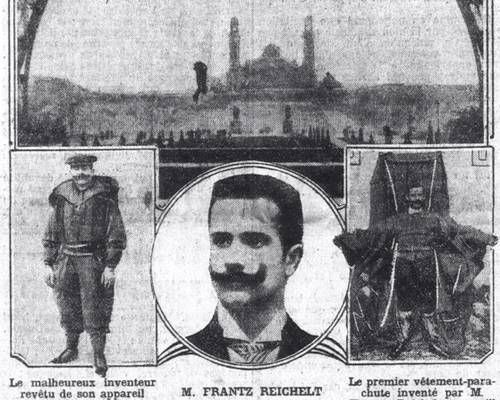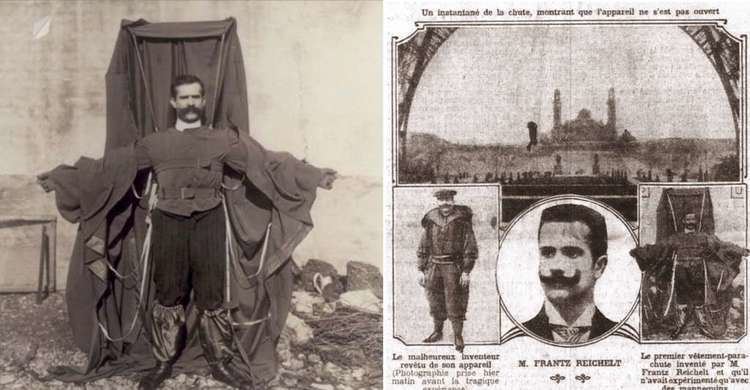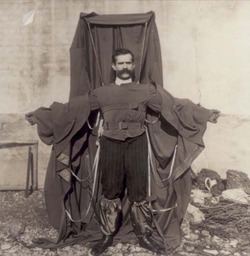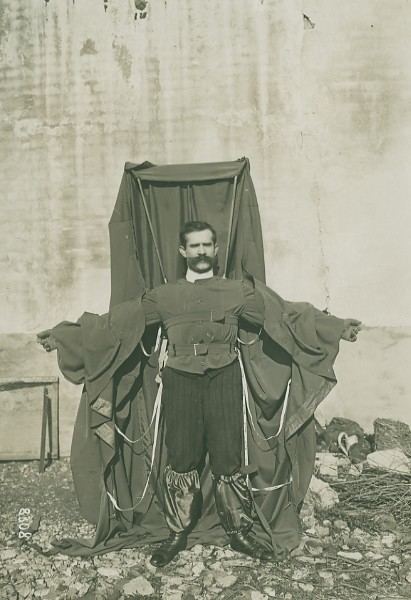Name Franz Reichelt | Role Tailor | |
 | ||
Died | ||
Franz reichelt eiffel tower jump
Franz Reichelt (1879 – 4 February 1912), also known as Frantz Reichelt or François Reichelt, was an Austrian-born French tailor, inventor and parachuting pioneer, now sometimes referred to as the Flying Tailor, who is remembered for jumping to his death from the Eiffel Tower while testing a wearable parachute of his own design. Reichelt had become fixated on developing a suit for aviators that would convert into a parachute and allow them to survive a fall should they be forced to leave their aircraft. Initial experiments conducted with dummies dropped from the fifth floor of his apartment building had been successful, but he was unable to replicate those early successes with any of his subsequent designs.
Contents
- Franz reichelt eiffel tower jump
- Death jump franz reichelt jumps off the eiffel tower
- Early experiments
- Eiffel Tower jump
- Aftermath
- References

Believing that the lack of a suitably high test platform was partially to blame for his failures, Reichelt repeatedly petitioned the Parisian Prefecture of Police for permission to conduct a test from the Eiffel Tower. He was finally granted permission in early 1912, but when he arrived at the tower on 4 February he made it clear that he intended to jump himself rather than conduct an experiment with dummies. Despite attempts by his friends and spectators to dissuade him, he jumped from the first platform of the tower wearing his invention. The parachute failed to deploy and he crashed into the icy ground at the foot of the tower. Although it was clear that the fall had killed him, he was taken to a nearby hospital where he was officially pronounced dead. The next day, newspapers were full of the story of the reckless inventor and his fatal jump – many included pictures of the fall taken by press photographers who had gathered to witness Reichelt's experiment – and a film documenting the jump appeared in newsreels.

Death jump franz reichelt jumps off the eiffel tower
Early experiments

Reichelt was born in Wegstädtl, Austrian Empire (today, Štětí, Czech Republic) in 1879 and moved to Paris in 1898. He obtained French nationality in 1909, adopting the first name François (the French equivalent of the Germanic "Franz"). One of his sisters may have also come to France and been married to a jeweller there, but newspaper reports differed on the details of his family life, with most reporting that his sisters stayed in Vienna. Reichelt himself was unmarried. He took an apartment on the third floor at 8 rue Gaillon near the Avenue de l'Opera from 1907 (which he rented for 1500 francs a year) and opened what was to become a successful dressmaking business, catering mostly to Austrians on trips to Paris. From July 1910, he began to develop a "parachute-suit": a suit that was not much more bulky than one normally worn by an aviator, but with the addition of a few rods, a silk canopy and a small amount of rubber that allowed it to fold out to become what Reichelt hoped would be a practical and efficient parachute.

The dawn of the aviation age brought inevitable accidents coupled with a growing interest in safety measures, most notably in the development of an effective parachute. Early parachuting successes, such as those by Louis-Sébastien Lenormand in 1783 and by balloonist Jean-Pierre Blanchard, had used fixed-canopy parachutes (that were already "open" before the jump began), and although André-Jacques Garnerin had invented a frameless parachute suitable for use from high altitudes, by 1910 a parachuting solution that was suitable for use when jumping from a plane or at low altitude had yet to be developed. Reichelt seems to have become interested in parachute design after hearing some of the stories of fatal accidents among the early aeronauts and aviators. His early tests with dummies equipped with foldable silk "wings" were a resounding success: dropped from the fifth floor, they touched down lightly. Attempts to convert the initial prototype parachutes into a workable suit proved difficult. Reichelt's original design weighed around 70 kilograms (150 lb) and used 6 square metres (65 sq ft) of material. He presented his design to the leading aeronautic organization, La Ligue Aérienne at the Aéro-Club de France, hoping that they would test it, but they rejected his designs on the grounds that the construction of the canopy was too weak, and they attempted to dissuade him from wasting his time on further development. Undaunted by the rejection, Reichelt persevered and conducted experimental drops with dummies from the courtyard of his building at rue Gaillon. None of his tests proved successful.
In 1911, Colonel Lalance wrote to the Aéro-Club de France, offering a prize of 10,000 francs for a safety parachute for aviators – double the prize he had offered the year before. The competition was open for three years and stipulated that the parachute must weigh no more than 25 kilograms (55 lb). Eager to participate, Reichelt refined his design, reducing the weight while increasing the surface area of the material until it reached 12 square metres (130 sq ft). Further tests proved no more successful than his earlier attempts: his dummies invariably fell heavily to earth. L'Ouest-Éclair reported that in 1911 he had then made a jump himself from a height of 8 to 10 metres (26 to 33 ft) at Joinville. The attempt failed but his fall was cushioned by a pile of straw, which helped him escape injury. Le Matin reported an attempt at Nogent from a height of 8 metres (26 ft) that resulted in a broken leg. Le Petit Journal suggested that he also made at least two apparently inconclusive tests with dummies from the first deck of the Eiffel Tower during 1911, but an interview with one of Reichelt's friends in La Presse made it clear that he had been unsuccessfully applying for permission to conduct a test from the Eiffel Tower for over a year before he finally received the authorization for the final jump. There had been other tests from the tower during 1910 and 1911 though; Gaston Hervieu, who employed a dummy aircraft and mannequins in his experiments, was attempting to perfect a parachute design to ensure the safe landing of a pilot with all or part of a damaged aircraft. Reichelt attributed the failures of his designs at least in part to the short drop distances over which he had conducted his tests, so he was keen to receive permission to experiment from the Eiffel Tower.
Eiffel Tower jump
Reichelt announced to the press in early February 1912 that he had finally received permission and would shortly conduct an experiment from the Eiffel Tower to prove the value of his invention.
On Sunday, 4 February, at 7:00 a.m., he arrived at the tower by car with two friends. He was already wearing his parachute suit. The news footage of his jump shows him modelling his invention in its folded form, which Le Gaulois described as "... only a little more voluminous than ordinary clothing ..." ("... un peu plus volumineuse qu’un vêtement ordinaire ..."). The suit did not restrict the wearer's movements when the parachute was packed, and Le Petit Parisien described the method of deploying the parachute as being as simple as extending the arms out to form a cross with the body. Once extended, the outfit resembled "a sort of cloak fitted with a vast hood of silk" ("une sorte de manteau, muni d'un très vaste capuchon de soie") according to Le Temps. L'Action Française reported that Reichelt stated the surface area of the final design to be 30 square metres (320 sq ft) with a canopy height of 5 metres (16 ft), while Le Figaro judged the surface area might have reached 32 square metres (340 sq ft). La Croix claimed that the suit may have weighed as little as 9 kilograms (20 lb). The weather was cold, with temperatures below 0 °C (32 °F), and there was a stiff breeze blowing across the Champ de Mars.
There were some police officers present to maintain order, as the Parisian Prefecture of Police had given Reichelt permission to proceed. After Reichelt's death, M. Louis Lépine who, as the Prefect of Police (Préfet de Police), was ultimately responsible for the permission being granted, issued a statement making it clear that while the police routinely gave permission for experiments to be performed from the Eiffel Tower, it was understood in these cases that dummies would be used. They had given permission in Reichelt's case only on the basis that he would be conducting dummy drops, and that under no circumstances would they have allowed him to proceed if they had known he would be making the jump himself. M. Lépine assured La Croix that he had never signed an order that allowed a live jump. From his arrival at the tower, however, Reichelt made it clear that he intended to jump himself. According to a later interview with one of the friends who accompanied him up the tower, this was a surprise to everybody, as Reichelt had concealed his intention until the last moment. His friends tried to persuade him to use dummies in the experiment, assuring him that he would have other opportunities to make the jump himself. When this failed to make an impression on him, they pointed to the strength of the wind and said he should call off the test on safety grounds, or at least delay until the wind dropped. They were unable to shake his resolve; seemingly undeterred by the failure of his previous tests, he told journalists from Le Petit Journal that he was totally convinced that his apparatus would work, and work well. When questioned as to whether he planned to take any additional precautions, such as using a safety rope, he replied that he would not, since he intended to trust his life entirely to his parachute:
I want to try the experiment myself and without trickery, as I intend to prove the worth of my invention. (Je veux tenter l’expérience moi-même et sans chiqué [sic], car je tiens à bien prouver la valeur de mon invention.)
M. Hervieu, who was present to witness the demonstration, also attempted to dissuade him from making the jump. He was concerned that the parachute needed longer to fully open than the few seconds the drop from the first platform would allow, and he also presented other technical objections to which Reichelt could not provide a satisfactory response. Reichelt finally replied that:
You are going to see how my seventy-two kilos and my parachute will give your arguments the most decisive of denials. (Vous allez voir comment mes soixante-douze kilos et mon parachute vont donner à vos arguments le plus décisif des démentis.)
Ropes had been suspended between the legs of the tower by the police at Reichelt's request to prevent the crowds from spilling onto the landing zone, and he spent some time discussing the arrangements with the marshals and ensuring that there was sufficient space for his landing before going to the stairs to climb to the first platform.
According to Le Petit Parisien, Reichelt's initial attempt to ascend to the first stage of the tower was blocked by a guard, M. Gassion, who had witnessed previous unsuccessful dummy drops and feared that Reichelt's attempt would end in disaster, though Le Figaro reported that he had merely not received a copy of the order and had to wait for telephone confirmation from his superiors. Despite the guard's resistance, by 8:00 a.m. the matter had been resolved: Reichelt, who was visibly shaken by his argument with the guard, was allowed to mount the tower with his two friends and a cinematographer (another was stationed near the foot of the tower to record the jump from below). As he climbed the stairs he paused, turned back to the crowd, raised his hand and wished them a cheery "À bientôt". (See you soon). His friends continued to try to talk him out of the jump, but Reichelt was quite determined. At 8:22 a.m., observed by a crowd of about 30 journalists and curious onlookers, he readied himself – facing towards the Seine – on a stool placed on a restaurant table next to the interior guardrail of the tower's first deck, a little more than 57 metres (187 ft) above the ground. After adjusting his apparatus with the assistance of his friends and checking the wind direction by throwing a piece of paper taken from a small book, he placed one foot on the guardrail, hesitated for about 40 seconds, then leapt outwards. According to Le Figaro, he was calm and smiling just before he jumped. His parachute, which had seemed to be only half-open, folded around him almost immediately and he plummeted for a few seconds before crashing into the frozen soil at the foot of the tower.
Le Petit Parisien reported that his right leg and arm were crushed, his skull and spine broken, and that he was bleeding from his mouth, nose and ears. Le Figaro noted that his eyes were wide open, dilated with terror. He was already dead by the time the onlookers rushed to his body, but he was taken to the Necker hospital where he was officially pronounced dead, and then on to a police station in the rue Amelie before being returned to his home in rue Gaillon.
Aftermath
The next day's newspapers were full of the story of Reichelt's "tragic experiment" ("expérience tragique") complete with photographs; at least four newspapers, Le Petit Parisien, L'Humanité, Le Matin and La Croix, showed images of the fatal jump. Film of the attempt, including footage of Reichelt's body being removed and the onlookers measuring the depth of the hole created by his impact (15 centimetres; 5.9 in), was distributed by news organizations. Initial reports speculated on Reichelt's state of mind: none assumed he had been suicidal, but many called him reckless or foolish. A journalist in Le Gaulois suggested that only half the term "mad genius" applied to Reichelt – although the same report included an interview with one of Reichelt's friends, who claimed that the tailor had felt pressured into giving a dramatic demonstration to attract sponsors, without whom he could not expect to make a profit before any patent expired. Reichelt's death was the first to result from a parachuting accident since Charles Leroux died giving a demonstration in Tallinn in 1889. In fact, on 2 February 1912 – two days prior to Reichelt's fatal jump – an American steeplejack, Frederick R. Law, had successfully parachuted from the viewing platform of the torch of the Statue of Liberty (223 feet (68 m) above sea level and 151 feet (46 m) from the base of the statue), seemingly on a whim. On 6 February, La Croix added a footnote to the report on Reichelt's death: another parachuting experiment was to take place on 18 or 25 February at Juvisy-sur-Orge, in which the aviator Camille Guillaume planned to leap from his Blériot monoplane at a height of 300 metres (980 ft) to test a parachute design (the plane would be allowed to crash).
After Reichelt's death, the authorities were wary of granting permission for experiments from the Eiffel Tower. Though they continued to grant permissions for parachute dummy drops, some hopeful inventors – such as M. Damblanc, who wished to try his "helicopter parachute" from the second platform – were refused permission to conduct tests, and even applications for aviation experiments not involving the tower came under renewed scrutiny. More recently, the tower has been the scene of a number of illicit base jumps. A Norwegian man died in 2005 after losing his canopy while attempting a promotional jump for a clothing firm – the first parachuting death at the tower since Reichelt. A sanctioned stunt jump for the 1985 James Bond film A View to a Kill was successful.
Reichelt came momentarily to prominence again in the 1940s in the United States, when his likeness was claimed as the model for one of the figures that were "strangely un-American in expression and garb" in the WPA-funded mural at Floyd Bennett Field in Brooklyn. In an incident reminiscent of the 1933 controversy over Diego Rivera's Man at the Crossroads mural at the Rockefeller Center in New York City, a furore erupted over an image depicting two minor leftist aviators, supposedly flanking a central portrait of Joseph Stalin. The WPA already had an unwanted reputation as sympathetic to the left, and despite the artist August Henkel's "glib" explanation of the "accidental" inclusion of a Soviet red star and his claim that the image identified as Stalin was actually of Reichelt, the murals were taken down and three of the four panels burned. The story of Reichelt's misadventure was also the subject of a 1993 French short, Le Tailleur Autrichien, written and directed by Pablo Lopez Paredes and starring Bruce Myers in the title role.
Although there were no viable parachuting solutions for use in aeroplanes when Reichelt began developing his suit, by the time of his death a successful parachute jump from a plane using a non-fixed canopy had already taken place in the United States, and a patent for a packable parachute had been applied for by Gleb Kotelnikov.
